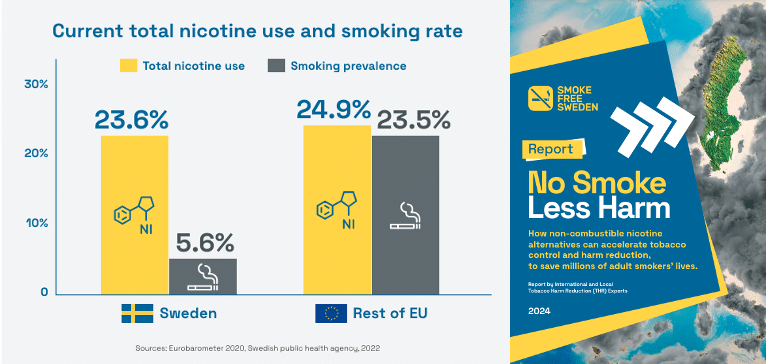
12 studies: The public health benefits of Swedish snus
What does the science say about the public health benefits of Swedish snus? Snusforumet has put together a handy list of 12 studies demonstrating the harm reduction effects of snus.
Most people agree that Swedish snus is significantly less harmful than cigarettes. Many thus accept that snus has a harm-reducing effect by serving as a substitute for deadly cigarettes.
Yet despite an increasingly large body of research demonstrating the public health benefits of Swedish snus, many anti-tobacco activists, politicians, and government officials continue to equate snus and cigarettes.
But what does the research actually tell us?
Snusforumet has compiled 12 scientific articles and research studies examining the harm reduction effects of Swedish snus and its potential as a smoking cessation tool.
Studies about Sweden
Through cross-sectional data from northern Sweden, Rodu et al. (2003) conclude that snus has played a major role in reducing smoking among men in the north of the country. The development takes public health policy reforms into account and is probably due to historical and societal influences. In a similar study, Lund et al. (2010) examine the prevalence of snus use and discontinued cigarette use in Norway. As in Sweden, the Norwegian study shows that snus use is associated with an increased probability of successfully quitting smoking.
Foulds et al (2003) have conducted a research review of articles and other data sources on snus use, other tobacco use, and changes in public health in Sweden. The research review shows that Swedish snus does not appear to cause cancer or respiratory diseases, but it can increase the risk of heart disease and be harmful to the fetus, even if the risk of this is significantly lower for snus users than for smokers. Research also shows that the proportion of men in Sweden who smoke decreased by 25 percent between 1976 and 2002, while the decrease for women amounts to 14 percent during the same period. About 30 percent of men have switched to snus when they quit smoking, which has resulted in a significant decrease in the proportion of men in Sweden who develop lung cancer.
McNeill & Munafò (2012) discusses the benefits of using alternative nicotine and tobacco products as risk-reducing agents to reduce cigarette use. They use Sweden as an example of a country which, despite relatively high tobacco use, has succeeded in reducing tobacco-related diseases by reducing the use of cigarettes through a transition to snus. The decrease primarily refers to Swedish men who today have Europe’s lowest incidence of both respiratory diseases and oral cancer.
In a study based on data from the Swedish Twin Registry, Furberg et al. (2008) examine whether Swedish snus contributes to an increased or decreased risk of starting to smoke. The researchers conclude that snus to a greater extent leads to people quitting instead of starting to smoke.
Rodu et al. (2009) confirm that the use of snus is an important factor in the low prevalence of smoking, especially among younger men and women in northern Sweden. The purpose of this study was to describe tobacco use in the 2009 Northern Sweden cohort from the WHO’s Multinational Monitoring of Trends and Determinants in Cardiovascular Disease (MONICA) study. Information on smoking and snus use was collected through surveys conducted in Norrbotten and Västerbotten in 1986, 1990, 1994, 1999, and 2004. This study confirms that the use of snus is an important factor in the low prevalence of smoking, especially among younger men and women in northern Sweden.
Studies about Norway
Lund and McNeill (2013) have studied the dual-use of snus and cigarettes among Norwegian men. In the study, the researchers compared users of both snus and cigarettes with users of only cigarettes in terms of intensity of smoking, plans to quit smoking, and their future smoking. The study examined a total of 3,524 men aged 16-74 years, of whom 6.8 percent had combined use of snus and cigarettes but only one percent reported using both products daily. The study shows that users with dual-use smoke significantly fewer cigarettes than users who have stopped using snus or never used snus. 53.6 percent of users who use snus daily state that the purpose of their snus use is to stop smoking. The results also show that dual users to a greater extent expect to be smoke-free within five years.
Scheffels et al (2012) have studied the prevalence of snus as a smoking cessation method among Norwegian men and women aged 16-74 years. The researchers conclude that snus is a common smoking cessation method among Norwegian men, while Norwegian women prefer nicotine therapy. The results reveal, for example, that 45.8 percent of men under the age of 45 who used snus in their latest attempt to quit smoking no longer used cigarettes. The results indicate that snus can be an effective method for quitting smoking.
Lund (2012) studied risk perception associated with snus and cigarettes as well as the connections between risk perception and the desire to use snus when quitting smoking. The study, which covered 14,744 Norwegian men aged 20-50, shows that only 22.9 percent of men who are daily smokers believe that snus is significantly less harmful. The remaining group considers either that the health risks for snus are similar to or greater than cigarettes (39.8 percent) or that snus constitutes a slightly lower risk (37.2 percent). Lund’s conclusion is that there are great opportunities to improve smokers’ health through information initiatives on the harm reduction effects of snus in countries where snus is allowed.
Other research studies
Le Houezec et al (2011) conducted a meta-study on nicotine therapy and snus as substitutes for cigarettes and smoking cessation products. The studies that the authors examined show that snus use can increase the risk of heart attack compared to people who have never used tobacco. However, studies show that snus use gives very little or no increased risk of oral cancer. One study referred to in the article concludes that snus is about 90 percent less dangerous than cigarettes. Sweden is an example of a country that has succeeded in reducing tobacco-related mortality with the help of snus and the researchers thus argue that the regulation of snus in the EU should be reviewed to enable similar reductions in other smoking-intensive EU countries.
Ramström & Wikmans (2011) draw conclusions from three different surveys that deal with tobacco use and conclude that snus use does not function as a gateway to smoking but rather counteracts smoking. The results also show that smokers who start using snus stop smoking to a greater extent than continue with dual use. Furthermore, the results show that snus use weakens rather than strengthens nicotine dependence and that smokers who start using snus are more likely to try to quit smoking.
Bertuccio et al. (2011) performed a pooled analysis of cigar and pipe smoking, smokeless tobacco use, and the risk of pancreatic cancer using data from eleven case and control studies. The results show that cigar smoking is associated with an increased risk of pancreatic cancer, while no significant association was found for pipe smoking and smokeless tobacco use such as snus.
Nilsson (2011) investigated the relationship between tobacco-specific nitrosamines and cancer. The conclusion is that low-nitrosamine products, such as snus, cannot be linked to DNA damage with statistical certainty, unlike high-nitrosamine products such as certain other chewing tobacco products.
Find more studies about Swedish snus by visiting Snusforumet’s Snus Science Database.
Subscribe to our newsletter
The Snusforumet newsletter is sent out about once a month and contains a summary of the latest snus and tobacco news.
By subscribing to our newsletter, you agree to allowing Snusforumet to use your email address to contact you with news and marketing. materials. Read more about how we process your personal information in our privacy policy.




